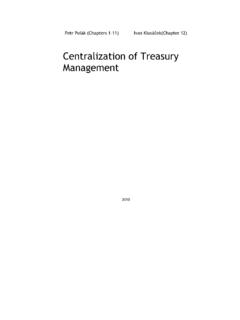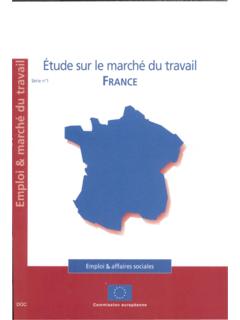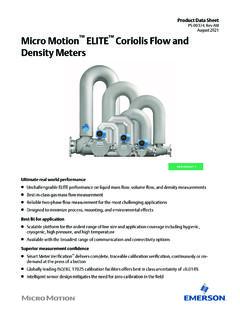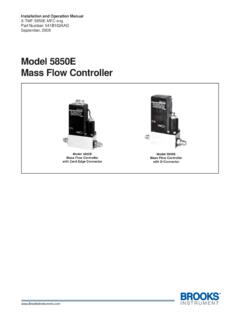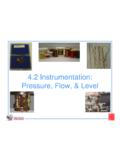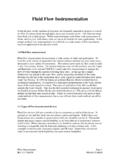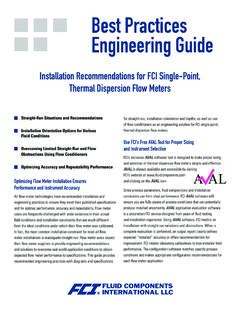Transcription of CONVERSION OF LEAK FLOW-RATES FOR VARIOUS FLUIDS …
1 Im;i ;./<2L&t<i Min EUR m m ',i*,i WWW hi nL'.fJ EAN ATOMIC ENERGY ft Bili il P if'll P' IMUNITY EURATOM Kil CONVERSION OF LEAK FLOW RATES FOR VARIOUS FLUIDS AND DIFFERENT pressure CONDITIONS I !* *'! 11 m ;n m\ " W" Hill I t 1966 IHDl' Pr m UW, j' i'1 Uil l ,H 'twAfiir ?M M il lil ifcn^ *> < * ORGEL Program Joint Nuclear Research Center Ispra Establishment - Italy Engineering Department Jlogy m mi m r iii' 'l' H"t';'- LEGAL NOTICE This document was prepared under the sponsorship of the Commission of the European Atomic Energy Community (EURATOM). Neither the EURATOM Commission, its contractors nor any person acting mm Malee any warranty or representation, express or implied, with respect to the accuracy, completeness, or usefulness of the information contained in this document, or that the use of any information, apparatus, method, or process disclosed in this document may not infringe privately owned rights; or Assume any liability with respect to the use of, or for damages resulting from the use of any information, apparatus, method or process disclosed in this document at the price of FF tth e addresses page !
2 ? a Bl" FB 50.~ DM 4, Lit. 620 FI. When ordering, please quote the EUR number and the title, which are indicated on the cover of each report, *>s,u iti j-Jirr bi Printed by Smeets Brussels, May 1966 t JsMJffeii is document was reproduced on the basis of the best available copy. EUR CONVERSION OF LEAK FLOW-RATES FOR VARIOUS FLUIDS AND DIFFERENT pressure CONDITIONS by J. AMESZ European Atomic Energy Community - EURATOM ORGEL Program Joint Nuclear Research Center - Ispra Establishment (Italy) Engineering Department - Technology Brussels, May 1966 - 50 Pages - 2 Figures - FB 50 This report contains in a concise form the development of rules for CONVERSION of gas and liquid leakages. In many cases, for reasons of convenience, Ieaktightness of components is tested by means of a gaseous medium, although they actually operate with a liquid medium.
3 As leak EUR CONVERSION OF LEAK FLOW-RATES FOR VARIOUS FLUIDS AND DIFFERENT pressure CONDITIONS by J. AMESZ European Atomic Energy Community - EURATOM ORGEL Program Joint Nuclear Research Center - Ispra Establishment (Italy) Engineering Department - Technology Brussels, May 1966 - 50 Pages - 2 Figures - FB 50 This report contains in a concise form the development of rules for CONVERSION of gas and liquid leakages. In many cases, for reasons or convenience, Ieaktightness of components is tested by means of a gaseous medium, although they actually operate with a liquid medium. As leak EUR CONVERSION OF LEAK FLOW-RATES FOR VARIOUS FLUIDS AND DIFFERENT pressure CONDITIONS by J. AMESZ European Atomic Energy Community - EURATOM ORGEL Program Joint Nuclear Research Center - Ispra Establishment (Italy) Engineering Department - Technology Brussels, May 1966 - 50 Pages - 2 Figures - FB 50 This report contains in a concise form the development of rules for CONVERSION of gas and liquid leakages.
4 In many cases, for reasons of convenience, Ieaktightness of components is tested by means of a gaseous medium, although they actually operate with a liquid medium. As leak mechanisms of a liquid and a gas are often principally different, CONVERSION requires the application of appropriate correlations. Based on theoretical considerations, such correlations are derived and presented in this paper. mechanisms of a liquid and a gas are often principally different, CONVERSION requires the application of appropriate correlations. Based on theoretical considerations, such correlations are derived and presented in this paper. mechanisms of a liquid and a gas are often principally different, CONVERSION requires the application of appropriate correlations. Based on theoretical considerations, such correlations are derived and presented in this paper.
5 EUR EUROPEAN ATOMIC ENERGY COMMUNITY - EURATOM CONVERSION OF LEAK FLOW-RATES FOR VARIOUS FLUIDS AND DIFFERENT pressure CONDITIONS by J. AMESZ 1 966 ORGEL Program Joint Nuclear Research Center Ispra Establishment - Italy Engineering Department Technology CONTENTS Introduction Leak Detection Facilities The differential- pressure metho The He mass -spectrometer . The Spediva leak detector Liquid leak measurements . The Flow-rate through a Leak . Gas leakages .. Liquid leakages 4. The Geometry of a Leak . 5. CONVERSION of VARIOUS Fluid FLOW-RATES Mathematical CONVERSION of leak FLOW-RATES Gas and liquid FLOW-RATES The average diameter of the capillaries . Graphical CONVERSION of leak FLOW-RATES . CONVERSION of gas FLOW-RATES at vacuum and exit- pressure atmospheric ().
6 CONVERSION for Different pressure Conditions 7. The Influence of the Temperature on the Leak Flow-rate 8. Application Examples of Leak I" low-Rate Calculations and Con-versions for Organic Liquid (Terphenyl OM2) 9. Conclusions Page 1 2 2 5 5 5 5 5 IO 14 15 16 16 19 20 22 25 24 25 28 SUMMARY I his report contains in a concise form the development of rules for CONVERSION ol gas and liquid leakages. In many cases, for reasons of convenience. Ieaktightness of components is tested by means of a gaseous medium, although they actually operate with a liquid medium. As leak mechanisms of a liquid and a gas are often principally different, CONVERSION requires the application of appropriate correlations. Based on theoretical considerations, such correlations are derived and presented in this paper.
7 - 1 -1. INTRODUCTION The primary requirement for a sealing will he a maximum degree of Ieaktightness. Several methods of measuring "both gas-leakages and liquid-leakages will "be discussed shortly, since quantitatively, the Ieaktightness of a sealing can only he determined by measuring leakages. However, often the circumstances and conditions during measuring are not identical to those during operation. Consequently, in many cases it will he necessary to convert leak data obtained with a certain measuring system, to conditions equal to actual operating conditions. In making such conversions the following para-meters should he taken into account: Test-fluid (gas and liquid) Fluid flow CONVERSION is often necessary for one of the following reasons: - In many cases a measuring method for liquid leaks is not sensitive enough or does not exist, so a gas is used as a test medium instead of the liquid itself. - Sometimes leaks are measured with a special test gas, as for instance, helium, when a mass -spectrometer is used as leak-test apparatus.
8 pressure (vacuum, atmospheric- pressure and over- pressure ) CONVERSION of leak FLOW-RATES at different pressures will he needed mainly for the following reason: Most of the gas leakages are measured either by means of the mass -spectrometer or with the differential- pressure method, consequently under vacuum. However, at operation conditions the working- pressure will not be a vacuum, but an over- pressure . Temperature For ease and accuracy, leak-measurements are mostly per-foj-msd at ambient temperature, which in most cases does not correspond with reality. 2 In this report CONVERSION theories will be presented, giving leak flow rate formulae for and relationships be tween the above mentioned parameters. 2. LEAK DETECTION FACILITIES In order to measure or to detect a gas leak,of the many existing possibilities, the following methods are chosen either because of the simplicity, the sensitivity or the handiness: the differential pressure method the He mass spectrometer the "Speedivac" leak detector.
9 With these few methods small leakages can be measured as well as larger ones. The differential pressure method The object which has to be tested for leakages is evac uated. When the pressure is low enough, a valve is closed separating the object from the vacuum pump. Then the to tal leakage can be, calculated from the pressure rise during a certain time interval with the following formula: Q = -r . lusec, in which V = volume of the object in litres t = time interval in sec = pressure rise in llg during t sec. With this method the measurements are often influenced by outgassing and background leakages of the vacutun system, A theoretical relation has been derived by means of which the outgassing and background leakages can be eliminated. Therefore VARIOUS measurements at different fill pressures should be performed (see chapter 5). It will be clear that the method will be more sensitive for a smaller volume and a higher fill pressure .
10 In that case very small leaks, in the order of magni tilde of - " lusec, could be measured. On the other hand an object under over- pressure can be tested by measuring the pressure -drop at the fill-pres sure side of the leak. In this case, the total leakage is also calculated by means of the above mentioned for mula. The He mass -spectrometer The principle of the mass -spectrometer is based on the fact that gas ions, being in a magnetic field, will fol low a circular path of which the radius depends on their charge and mass . Gas ions with a certain molecular weight can thus be separated from other ions in a mixture. The spectrometer can only be operated at low pressure (about 10""' ^), so that an extensive vacuum installation will be needed, consisting of at least a fore-pump and a dif fusion pump in series. In order to measure the leakage a calibrated leak should be placed in the system. The mass -spectrometer is the most sensitive leak test apparatus.

